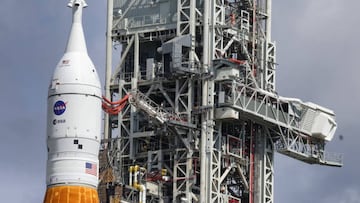How much is NASA’s Artemis lunar mission costing the US taxpayer?
NASA suffered a setback in its goal of reurning astronauts to the Moon in 2025 when its Artemis I launch was postponed on Monday.

NASA’s intended full-scale orbital test flight of its Space Launch System (SLS), the first mission of the agency’s Artemis programme designed to return astronauts to the surface of the Moon for the first time since Apollo 17 in 1972 and eventually pave the way for crewed missions to Mars, suffered a setback on Monday when a technical issue forced the launch to be postponed. NASA has two alternative launch windows slated for the test flight, on 2 September and 5 September.
Artemis I launch delayed
“The launch director halted today’s Artemis I launch attempt at approximately 8:34 a.m. EDT. The Space Launch System rocket and Orion spacecraft remain in a safe and stable configuration. Launch controllers were continuing to evaluate why a bleed test to get the RS-25 engines on the bottom of the core stage to the proper temperature range for liftoff was not successful, and ran out of time in the two-hour launch window. Engineers are continuing to gather additional data,” Nasa said in a statement.
The aim of Monday’s uncrewed SLS test was to run systems and hardware checks and put the Orion spacecraft, which will carry astronauts to the lunar surface, through its paces. Among the chief aims of the mission was to ensure that Orion’s heatshield can withstand the blistering 5,000f temperatures it will encounter on re-entry. The mission was slated to last up to 42 days, with Orion spending six days in lunar orbit.
The setback, while minor in the greater scheme of things, is another blow to NASA’s Artemis programme, which has come under scrutiny due to spiralling costs and delays. According to CNET, the agency has only budgeted for a single test flight before launching Artemis II, which will be crewed, in 2024. NASA is aiming to return astronauts to the Moon in 2025 when Artemis III is scheduled to launch.
The astronomical cost of NASA’s lunar mission
Originally budgeted at $10 billion, the total cost of the SLS rocket has now doubled to $20 billion. Each separate launch was originally expected to cost in the region of $500,000 but that has now increased eightfold to over $4 billion per launch. The overall cost of the Artemis programme up to 2025 is estimated at $93 billion.
NASA Inspector General Paul Martin told a session of the House Subcommittee on Space and Aeronautics in March that the launch cost estimate represented “a price tag that strikes us as unsustainable.”
Plans for the SLS were unveiled in 2012 and the Artemis programme was initiated in 2017, NASA’s first estimate of when SLS would be ready for a test launch.
SpaceX Starship project aiming for 2022 launch
Another factor in NASA’s timeline is Elon Musk’s rival Super-Heavy Starship project. The SpaceX founder has also slated a full-scale orbital test flight in 2022. Musk claimed earlier this year that each launch of his Starship rocket, which outsizes even the SLS, NASA’s most powerful rocket to date, would cost under $10m by using technology employed on SpaceX’s Falcon 9 programme, which recycles its rockets and boosters. The SLS by contrast is a single-launch rocket.
NASA and SpaceX are also working together on Artemis. The agency handed SpaceX a $2.89 billion contract to design the human landing system (HLS), which will be based on the company’s Starship programme and will serve as NASA’s initial moon lander to transport astronauts to the lunar surface from the Orion spacecraft. The HLS will be based on a system of orbital refuelling that has never been attempted before.






